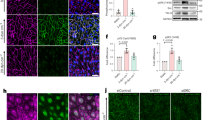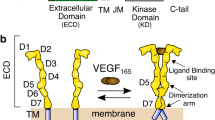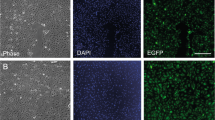Abstract
Activation of the tyrosine kinase receptor vascular endothelial growth factor receptor 2 (VEGFR2) by VEGF leads to the activation of stress-activated protein kinase (SAPK)2/p38 and then to actin polymerization and reorganization into stress fibers in endothelial cells. In turn, this triggers endothelial cell migration. Yet, nothing is known about the molecular mechanisms that couple VEGFR2 to SAPK2/p38. Here, we found that VEGF increased by twofold the activity of the small GTPase Cdc42 and that the expression of two different constitutively active forms of Cdc42 (Cdc42 V12 and Cdc42 L61) led to a marked increase in the formation of stress fibers that was sensitive to SAPK2/p38 inhibition by SB203580. Moreover, the expression of a dominant-negative form of Cdc42 (Cdc42 N17) inhibited the activation of SAPK2/p38 and of its direct target MAP kinase-activated protein kinase 2. These results indicate that Cdc42 is upstream of SAPK2/p38 in response to the activation of VEGFR2 by VEGF. In contrast, we found that neither RhoA nor Rac was involved in the SAPK2/p38-mediated actin reorganization induced by VEGF. Using a site-specific mutant of the major autophosphorylation site Y1214 on VEGFR2, we found that the mutant Y1214F inhibited the activation of both Cdc42 and SAPK2/p38 in response to VEGF. We conclude that phosphorylation of Y1214 on VEGFR2 is required to trigger the sequential activation of Cdc42 and SAPK2/p38 and to drive the SAPK2/p38-mediated actin remodeling in stress fibers in endothelial cells exposed to VEGF.
This is a preview of subscription content, access via your institution
Access options
Subscribe to this journal
Receive 50 print issues and online access
$259.00 per year
only $5.18 per issue
Buy this article
- Purchase on Springer Link
- Instant access to full article PDF
Prices may be subject to local taxes which are calculated during checkout








Similar content being viewed by others
Abbreviations
- ECGS:
-
endothelial cell growth supplement
- FAK:
-
focal adhesion kinase
- HSP:
-
heat-shock protein
- HUVEC:
-
human umbilical vein endothelial cells
- MAP kinase:
-
mitogen-activated protein kinase
- MAPKAP K2:
-
MAP kinase-activated protein kinase 2
- PAE:
-
porcine aortic endothelial cells
- SAPK:
-
stress-activated protein kinase
- VEGF:
-
vascular endothelial growth factor
- VEGFR2:
-
vascular endothelial growth factor receptor 2
References
Bagrodia S and Cerione RA . (1999). Trends Cell Biol., 9, 350–355.
Barleon B, Siemeister G, Martiny-Baron G, Weindel K, Herzog C and Marme D . (1997). Cancer Res., 57, 5421–5425.
Barry ST and Critchley DR . (1994). J. Cell Sci., 107, 2033–2045.
Bernatchez PN, Allen BG, Gelinas DS, Guillemette G and Sirois MG . (2001). Br. J. Pharmacol., 134, 1253–1262.
Bernatchez PN, Rollin S, Soker S and Sirois MG . (2002). J. Cell Biochem., 85, 629–639.
Carmeliet P, Ferreira V, Breier G, Pollefeyt S, Kieckens L, Gertsenstein M, Fahrig M, Vandenhoeck A, Harpal K, Eberhardt C, Declercq C, Pawling J, Moons L, Collen D, Risau W and Nagy A . (1996). Nature, 380, 435–439.
Clerk A, Pham FH, Fuller SJ, Sahai E, Aktories K, Marais R, Marshall C and Sugden PH . (2001). Mol. Cell. Biol., 21, 1173–1184.
Dechert MA, Holder JM and Gerthoffer WT . (2001). Am. J. Physiol. Cell Physiol., 281, C123–C132.
Edlund S, Landstrom M, Heldin CH and Aspenstrom P . (2002). Mol. Biol. Cell, 13, 902–914.
Fan WT, Koch CA, De Hoog CL, Fam NP and Moran MF . (1998). Curr. Biol., 8, 935–938.
Fantl WJ, Escobedo JA, Martin GA, Turck CW, del Rosario M, McCormick F and Williams LT . (1992). Cell, 69, 413–423.
Ferrara N and Bunting S . (1996). Curr. Opin. Nephrol. Hypertens., 5, 35–44.
Fong GH, Rossant J, Gertsenstein M and Breitman ML . (1995). Nature, 376, 66–70.
Huot J, Houle F, Marceau F and Landry J . (1997). Circ. Res., 80, 383–392.
Huot J, Houle F, Rousseau S, Deschesnes RG, Shah GM and Landry J . (1998). J. Cell Biol., 143, 1361–1373.
Huot J, Lambert H, Lavoie JN, Guimond A, Houle F and Landry J . (1995). Eur. J. Biochem., 227, 416–427.
Huttenlocher A, Sandborg RR and Horwitz AF . (1995). Curr. Opin. Cell Biol., 7, 697–706.
Javerzat S, Auguste P and Bikfalvi A . (2002). Trends Mol. Med., 8, 483.
Kroll J and Waltenberger J . (1997). J. Biol. Chem., 272, 32521–32527.
Kroll J and Waltenberger J . (2000). Z. Kardiol., 89, 206–218.
Kyriakis JM and Avruch J . (2001). Physiol. Rev., 81, 807–869.
Lamarche N, Tapon N, Stowers L, Burbelo PD, Aspenstrom P, Bridges T, Chant J and Hall A . (1996). Cell, 87, 519–529.
Li X, Saint-Cyr-Proulx E, Aktories K and Lamarche-Vane N . (2002). J. Biol. Chem., 277, 15207–15214.
Masson-Gadais B, Houle F, Laferrière J and Huot J . (2003). Cell Stress Chaperon., 8, 37–52.
Meyer M, Clauss M, Lepple-Wienhues A, Waltenberger J, Augustin HG, Ziche M, Lanz C, Buttner M, Rziha HJ and Dehio C . (1999). EMBO J., 18, 363–374.
Mudgett JS, Ding J, Guh-Siesel L, Chartrain NA, Yang L, Gopal S and Shen MM . (2000). Proc. Natl. Acad. Sci. USA, 97, 10454–10459.
Nakamura M, Abe Y and Tokunaga T . (2002). Pathol. Int., 52, 331–339.
Pai KS and Cunningham DD . (2002). J. Neurochem., 80, 715–718.
Pai KS, Mahajan VB, Lau A and Cunningham DD . (2001). J. Biol. Chem., 276, 32642–32647.
Petrova TV, Makinen T and Alitalo K . (1999). Exp. Cell Res., 253, 117–130.
Polverini PJ . (2002). J. Dent. Educ., 66, 962–975.
Ratcliffe KE, Tao Q, Yavuz B, Stoletov KV, Spring SC and Terman BI . (2002). Oncogene, 21, 6307–6316.
Renkema GH, Pulkkinen K and Saksela K . (2002). Mol. Cell. Biol., 22, 6719–6725.
Ridley A . (2000). J. Cell Biol., 150, F107–F109.
Ridley AJ . (1999). Nat. Cell Biol., 1, E64–E66.
Rousseau S, Houle F and Huot J . (2000a). Trends Cardiovasc. Med., 10, 321–327.
Rousseau S, Houle F, Kotanides H, Witte L, Waltenberger J, Landry J and Huot J . (2000b). J. Biol. Chem., 275, 10661–10672.
Rousseau S, Houle F, Landry J and Huot J . (1997). Oncogene, 15, 2169–2177.
Sastry SK and Burridge K . (2000). Exp. Cell Res., 261, 25–36.
Sato Y, Kanno S, Oda N, Abe M, Ito M, Shitara K and Shibuya M . (2000). Ann. NY Acad. Sci., 902, 201–205 (discussion 205–207).
Seetharam L, Gotoh N, Maru Y, Neufeld G, Yamaguchi S and Shibuya M . (1995). Oncogene, 10, 135–147.
Sells MA, Knaus UG, Bagrodia S, Ambrose DM, Bokoch GM and Chernoff J . (1997). Curr. Biol., 7, 202–210.
Shalaby F, Rossant J, Yamaguchi TP, Gertsenstein M, Wu XF, Breitman ML and Schuh AC . (1995). Nature, 376, 62–66.
Songyang Z, Shoelson SE, Chaudhuri M, Gish G, Pawson T, Haser WG, King F, Roberts T, Ratnofsky S, Lechleider RJ, Neel BG, Birge RB, Fajardo JE, Chou MM, Hanafusa H, Schaffhausen B and Cantley LC . (1993). Cell, 72, 767–778.
Takahashi T, Ueno H and Shibuya M . (1999). Oncogene, 18, 2221–2230.
Takahashi T, Yamaguchi S, Chida K and Shibuya M . (2001). EMBO J., 20, 2768–2778.
Tibbles LA and Woodgett JR . (1999). Cell. Mol. Life Sci., 55, 1230–1254.
Van Trappen PO, Ryan A, Carroll M, Lecoeur C, Goff L, Gyselman VG, Young BD, Lowe DG, Pepper MS, Shepherd JH and Jacobs IJ . (2002). Br. J. Cancer, 87, 537–544.
Waltenberger J, Claesson-Welsh L, Siegbahn A, Shibuya M and Heldin CH . (1994). J. Biol. Chem., 269, 26988–26995.
Wu LW, Mayo LD, Dunbar JD, Kessler KM, Ozes ON, Warren RS and Donner DB . (2000). J. Biol. Chem., 275, 6059–6062.
Zeng H, Zhao D and Mukhopadhyay D . (2002a). J. Biol. Chem., 277, 4003–4009.
Zeng H, Zhao D and Mukhopadhyay D . (2002b). J. Biol. Chem., 19, 19.
Zhang S, Han J, Sells MA, Chernoff J, Knaus UG, Ulevitch RJ and Bokoch GM . (1995). J. Biol. Chem., 270, 23934–23936.
Acknowledgements
We thank Drs Nathalie Lamarche and Louise Larose from McGill University and Sylvain Bourgoin (Université Laval, Québec) for providing the various GTPase constructs and the GST-CRIB protein. We also thank Dr Jacques Landry (Québec) for providing the 9E10 antibody and NIH 3T3 cells and Drs Bruce Terman (New York) and Johannes Waltenberger (Ulm, Germany) for the VEGFR2 cDNA and PAE/VEGFR2 cells. We thank Dr François Marceau and the Department of Obstetrics of l'Hôpital St-François d'Assise for providing umbilical cords. We also thank André Lévesque and Éric Pèlerin for their help with microscopy and Dr Simon Rousseau and Éric Shink for the VEGFR2-NIH 3T3 cells. This work was supported by a grant from The Canadian Institutes of Health Research.
Author information
Authors and Affiliations
Corresponding author
Rights and permissions
About this article
Cite this article
Lamalice, L., Houle, F., Jourdan, G. et al. Phosphorylation of tyrosine 1214 on VEGFR2 is required for VEGF-induced activation of Cdc42 upstream of SAPK2/p38. Oncogene 23, 434–445 (2004). https://doi.org/10.1038/sj.onc.1207034
Received:
Revised:
Accepted:
Published:
Issue Date:
DOI: https://doi.org/10.1038/sj.onc.1207034
Keywords
This article is cited by
-
Soluble CD146, a biomarker and a target for preventing resistance to anti-angiogenic therapy in glioblastoma
Acta Neuropathologica Communications (2022)
-
Cdc42 subcellular relocation in response to VEGF/NRP1 engagement is associated with the poor prognosis of colorectal cancer
Cell Death & Disease (2020)
-
PKCθ-JunB axis via upregulation of VEGFR3 expression mediates hypoxia-induced pathological retinal neovascularization
Cell Death & Disease (2020)
-
Targeting tyrosine kinases for treatment of ocular tumors
Archives of Pharmacal Research (2019)
-
Decursin and decursinol angelate: molecular mechanism and therapeutic potential in inflammatory diseases
Inflammation Research (2018)



